Bombscapes: Of War and Earth
The Phasavaeng family pond is roughly 20 feet wide, 3 feet deep, and circled by a rocky path. It sits in a shady garden wedged between concrete homes, where the songs of birds and boisterous hens mostly drown out the sound of mopeds buzzing up and down the roads in this corner of Sekong, a small, impoverished city in southeastern Laos. The family suspects that a few bombs remain in the muck at the bottom of the pond, but nobody wants to go down there to check.
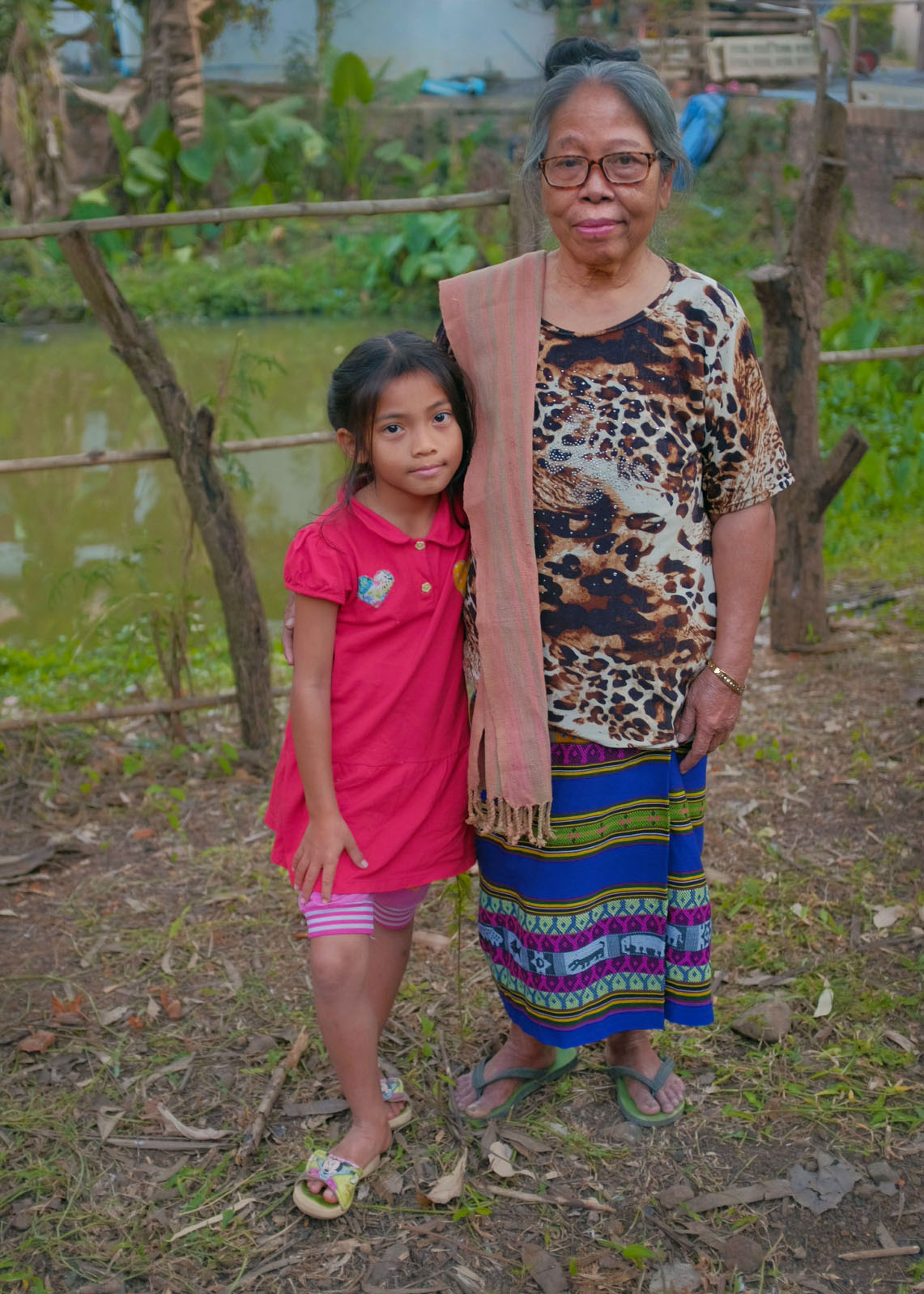
Loy Phasavaeng poses with one of her granddaughters in front of the bomb-crater pond in her backyard in southern Laos.
Loy Phasavaeng, a woman in her mid-70s, is the matriarch of the family. She is seated in a red plastic chair on the packed soil between her house and the pond. Her daughter, Phounsy Phasavaeng, now in her 40s, stands beside Loy, and tall stalks of bamboo, as well as coconut and banana trees, lean in around them. Morning glory, taro, and flowering lotus plants sit atop the pond, where flopping fish send ripples through the murky water. “It’s all food,” says Phounsy, who was born and raised in this part of Laos, where most people still fish, forage, and farm their own meals.
Loy says she was born in a small village 50 miles away, where life was also a matter of what she calls “self-help.” There were no markets, no trade. Nature supplied most things — cotton for clothes, wood for homes, foods from the forest. And when Loy grew up to have a family of her own, they planted rice, taro, cassava, and sweet potatoes there. And they survived.
Until they didn’t think they would.
Back in 1965, Laos was fully caught up in the violent ideological struggles of the Vietnam War and its proxies, and Loy says she recalls a particular day when she was working in the rice fields with her infant son — her firstborn — tied to her back. At some point she saw smoke, and she was terrified. “A lot of airplanes came,” Loy says, “and dropped many bombs.” Phounsy, who has been translating for her mother, begins to weep as Loy recalls the sense of panic she felt, knowing that her baby might be left motherless and alone if she were to be killed that day. For a moment, she says, she wondered if it would be best if they both died together.
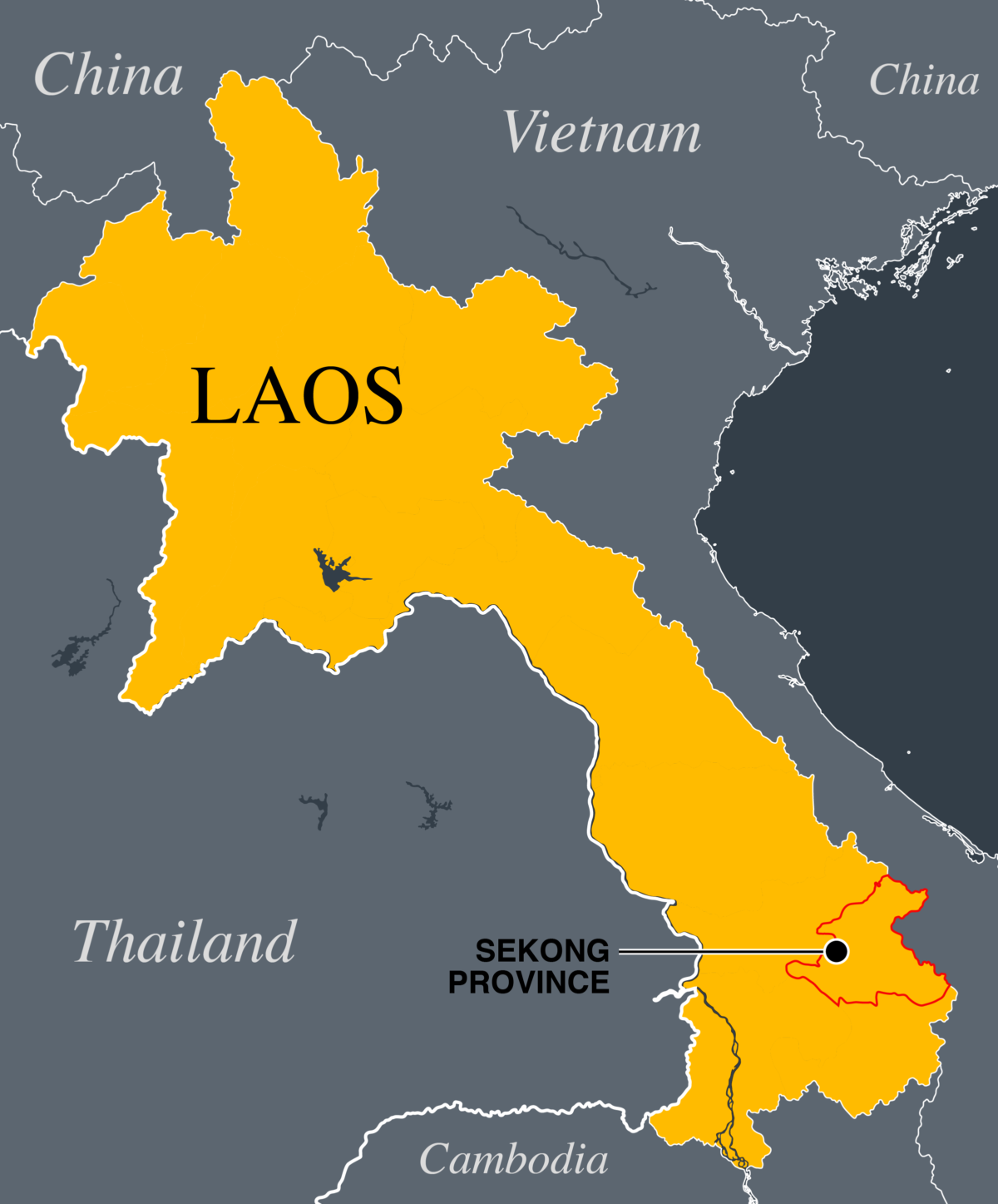
The family settled in Sekong after being displaced for more than a decade after the bombing stopped.
Mother and son survived, but the bombs kept coming — 2.5 million tons of them delivered by the United States alone — for another eight years. In that time, Loy says, neighbors fled, while others disappeared. At one point, Loy says, the Phasavaeng family dug a hole in the ground and burrowed inside. “We survived by hiding, sleeping in the bunker for many years,” she says.
When the war ended, the Phasavaengs moved from place to place, seeking suitable land to farm and opportunities for the children to attend school. In 1984, they settled in Sekong, where the land, including the small plot they acquired, was still scarred by bomb craters large and small, and littered with baseball-sized bomblets — the unexploded submunitions dispersed by larger cluster bombs. Locals call these “bombies,” and even now, 40 years later, millions of them remain, camouflaged as rocks or clumps of dirt, but still deadly.
“We collected more than 100 in the garden,” Loy says. A bomb-clearance team piled them into a crater and burned them all. Then the Phasavaengs did what many Laotians have done: They turned that crater into a fishpond, where her family raises tilapia, both for food and for sale.
And why not? That hole is here to stay. Millions of craters are, and villagers across the country turn them into fishponds, garbage dumps, wastewater pits, and plant nurseries.
People put the earth back to use — as they found it.
In this short documentary, filmmaker Jerry Redfern explains how bombs permanently alter landscapes, and the lives of people who live among the craters.
The craters are not just vestiges of war. They are geographic testaments to the anthropogenic force of bombs. Research shows that when a bomb bursts, it alters long-term soil formation, vegetation growth, and hydrology. It also affects how people use the land in the future. It’s a phenomenon so disruptive that it has given rise to a new field of science with an evocative name: bombturbation.
Simply put, bombturbation is the cratering of a land surface and “mixing the soil with an explosive device,” says Joseph P. Hupy, a geographer at the University of Wisconsin-Eau Claire and the father of the field. The device can be an aerial bomb, a propelled explosive, or an “in situ” bomb such as a landmine.
If you look at a cross-section of undisturbed soil, you’ll see horizons: surface vegetation and organic matter over topsoil, subsoil, parent material (partly weathered rock), and bedrock. A bomb blast shatters those horizons. It releases forceful energy that creates a supersonic shock wave, penetrating soil and rock, setting sediment in motion, and ejecting materials at high speed. A crater forms — its shape and dimensions dependent on the type and strength of the explosion, and the ground where it occurs. Explosions at or below the surface typically result in craters surrounded by a rim of ejected debris. Bedrock is often exposed in the bottom.
Each crater is unique, and its future depends on its environment. Over time, leaves and forest litter accumulate in the crater (if they are there), and water percolates through (or not). Organic matter seeps into the underlying bedrock, and microbes flourish (or not). Regardless of local conditions, the crater fosters a new soil environment that would not have evolved otherwise. Different plants take root. Runoff patterns shift. Creatures — human or otherwise — adapt to that new landscape in different ways. It’s not necessarily good or bad, but it’s changed — and that’s critical.
“When you start obliterating landscapes like this and engaging in bombturbation,” Hupy says, “it’s important to understand the long-term implications.” These combat scars are found not just on the former battlegrounds of the Vietnam conflict, including Laos and Cambodia, but in the rolling fields and farms of France, Belgium, Germany, and other countries pockmarked by the First and Second World Wars; in Syria, Iraq, Afghanistan, and other parts of the modern, war-torn Middle East; and everywhere else subjected to the percussion of heavy artillery. The number is nearly impossible to tally, but Hupy puts bomb-induced soil displacement in the 20th century alone in the billions of cubic meters.
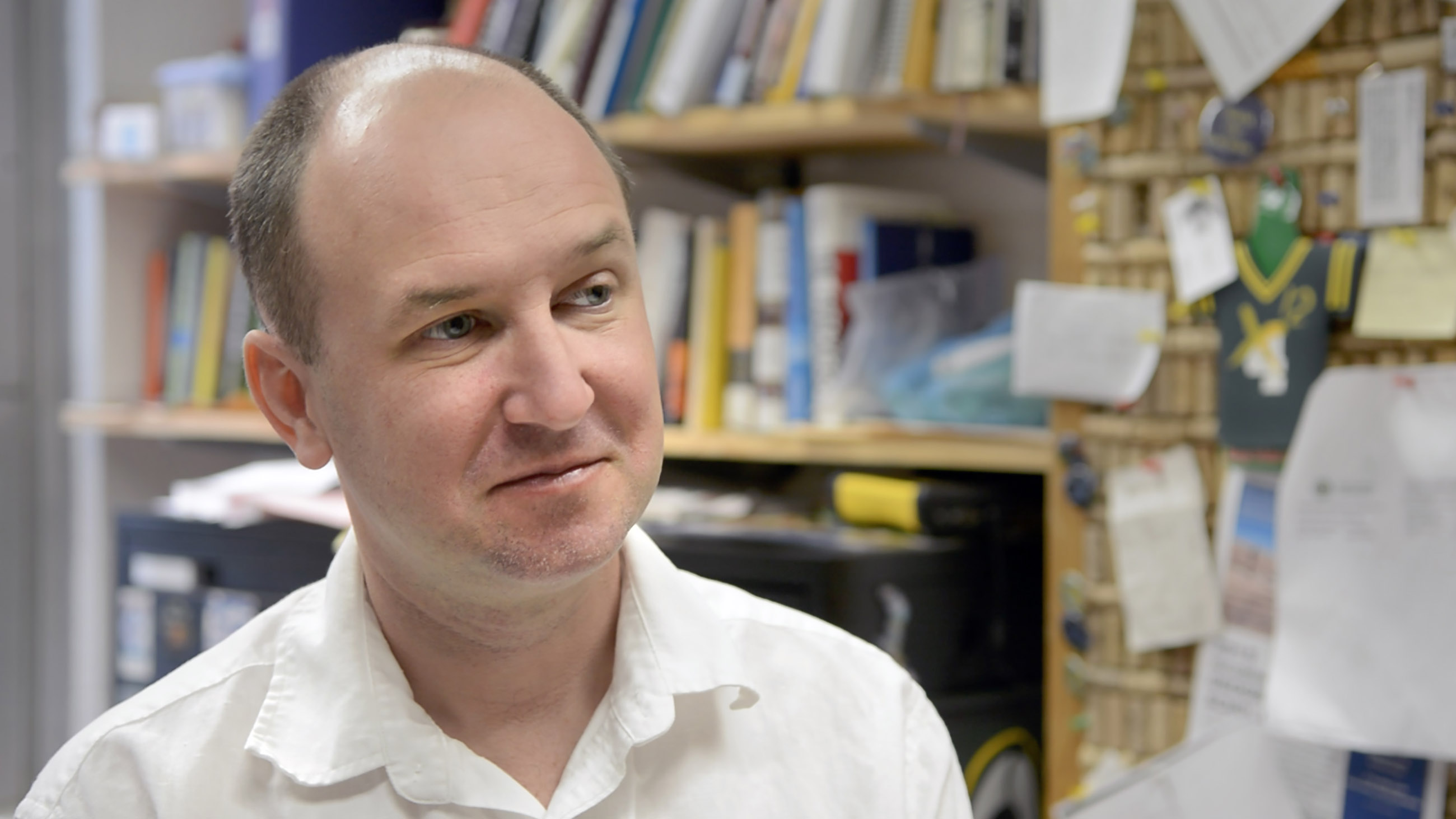
In other words: Humans are an impactful lot — so much so that many scientists argue that we deserve our own geologic epoch, called the Anthropocene. Some go even further, identifying an era they call the Technocene, to delineate a period of human and technological domination. But whatever the name, our prolific production, use, and dissemination of everything from aluminum and concrete to plastics and fertilizers is leaving a distinctive signature on the planet – not least in the form of sediment layers that are unlike those of earlier epochs.
And of all the ways humans affect the planet, “warfare is among the most destructive,” writes the biologist L. Wayne Dwernychuk. After all, the environmental toll of preparing for, fighting, and then cleaning up after a war is its own form of shock and awe. It has often involved not just jets, tanks, guns, and ammunition, but billions of gallons of fuel, tens of thousands of uniforms, and the erection of city-sized camps. It involves training sites and testing grounds, and it leaves behind, in varying degrees, a brutalized landscape of scorched earth, polluted fields, dead wildlife, spoiled habitat, and untold millions of tons of leftover ordnance. The terrain is never the same after war — which is why many scientists argue that bombturbation is a key marker of the Anthropocene. It’s “just one component of the bigger picture …,” Hupy says, “of how we’re shaping the face of our planet.”
Of all conflicts, the American War (as it is known in Southeast Asia) or the Vietnam War (as it is known in the United States) was the most environmentally catastrophic to date. Environmental destruction, in fact, was a primary military strategy, and the results endure today in millions of acres of denuded hills and damaged forests, as well as physical deformities attributed to Agent Orange and a scarred landscape of some 26 million craters. “Craters pock every area of South Vietnam: forests, swamps, fields, paddies, roadsides,” Arthur H. Westing and E. W. Pfeiffer wrote in 1972, more than a year before the onslaught ended.
Laos alone was hit with more than 4 billion pounds of bombs targeting the Ho Chi Minh Trail in the southeast, and communist insurgents in the north. More bombs were dropped on Laos, per capita, than on any other nation, in any other conflict, anywhere, ever.
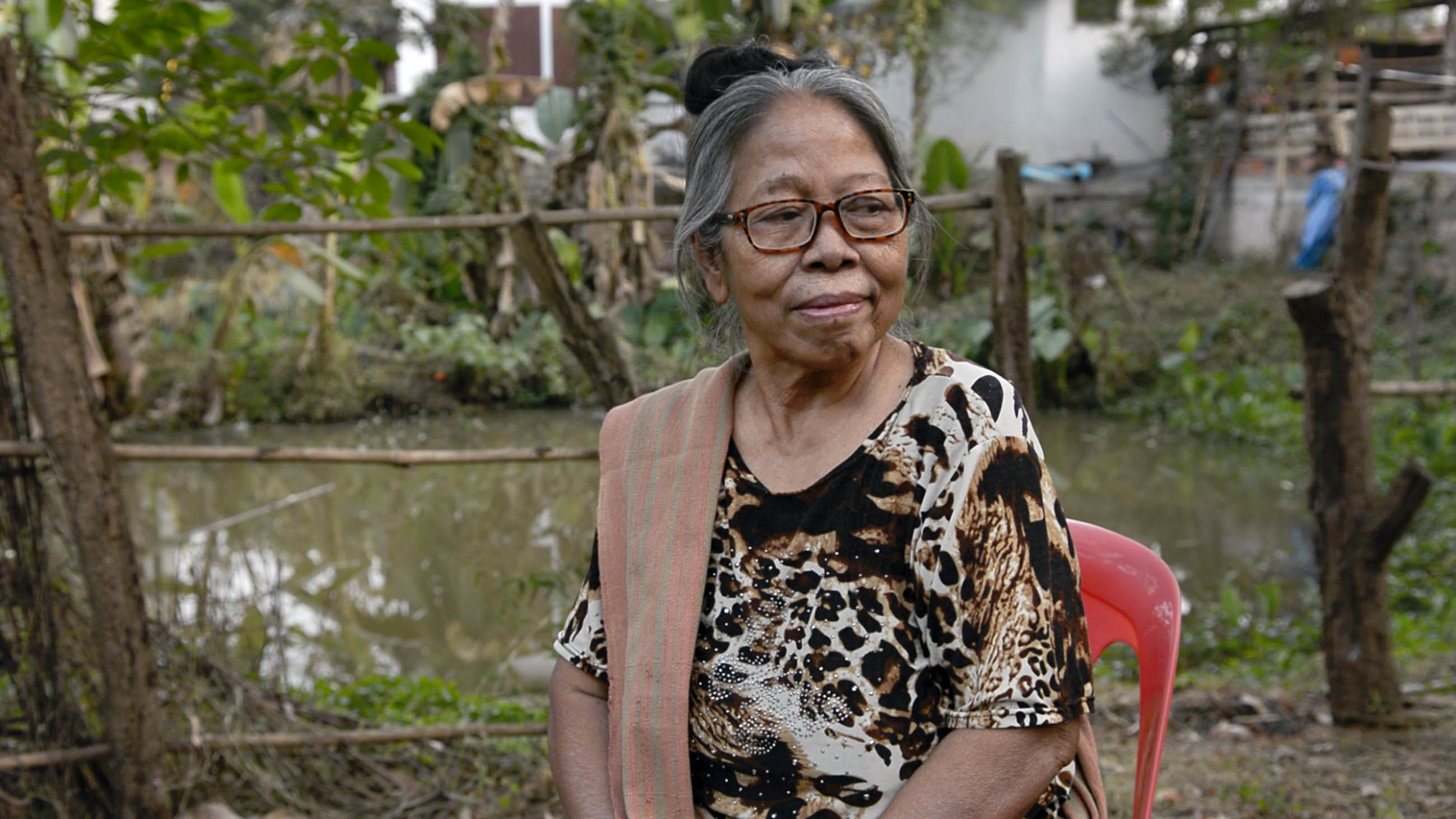

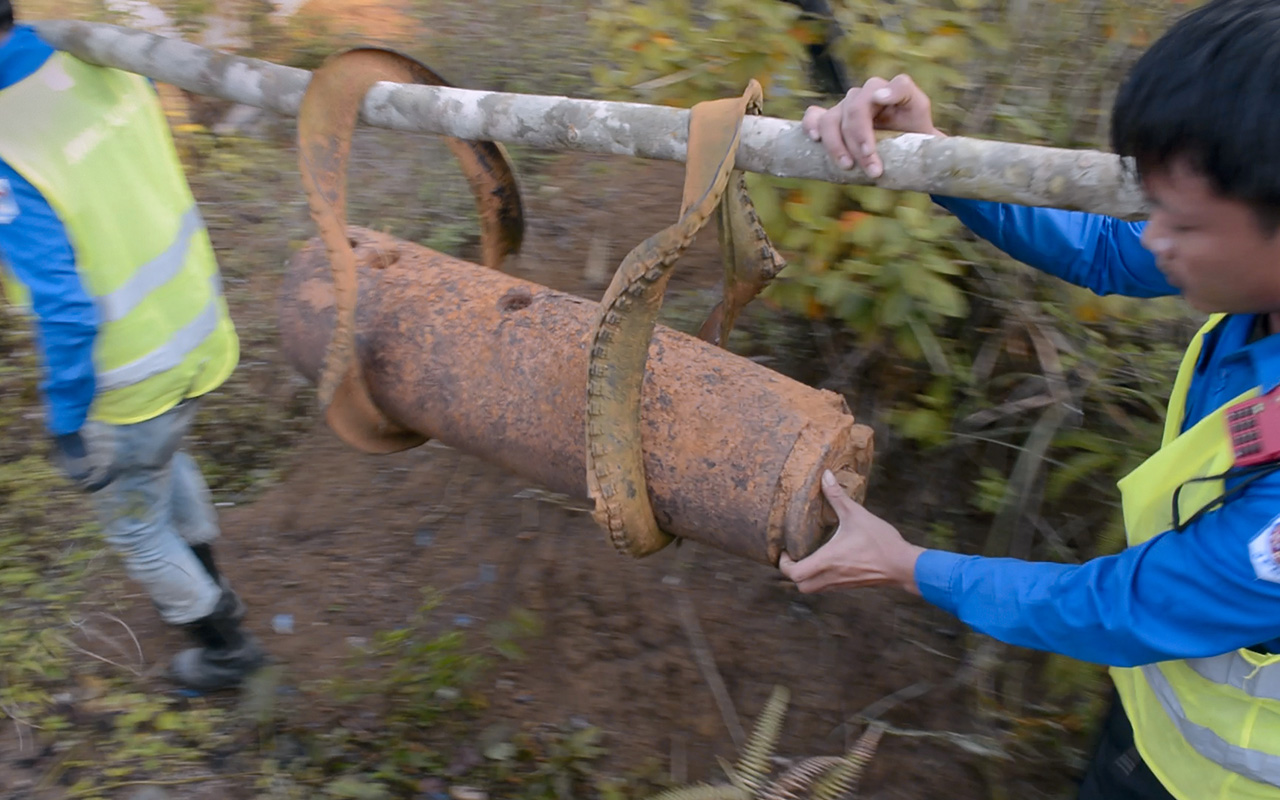
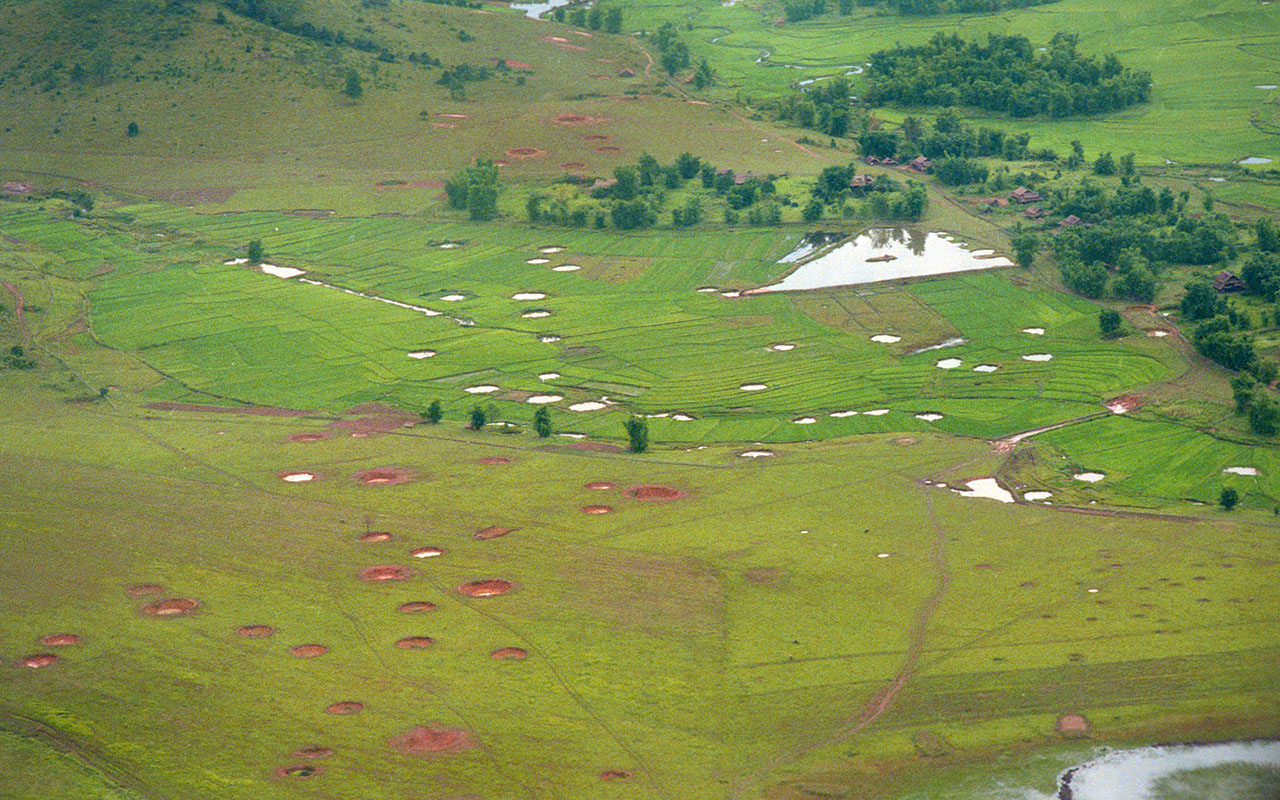
Almost a decade after the Phasavaeng family converted their crater into a fish pond, Hupy was studying for his Ph.D. in soil geomorphology more than 8,000 miles away in Michigan. “Soil is always being mixed,” he says. People dig, animals burrow, ice freezes and thaws, earthquakes fissure the land, and meteorites leave cavities when they crash. All of this disrupts, blends, or destroys soil horizons. The process, called pedoturbation (general mixing of soil), is divided into at least 11 subcategories based on what’s doing the mixing and how: aeroturbation (gas, air, wind), floralturbation (plants), crystalturbation (mineral crystals such as salts), aquaturbation (water), and so on.
In 2001, the young Hupy took a trip to Camp Grayling, a military training center in northern Michigan, to do a little soil research. The camp sits on 147,000 acres. Guardsmen practiced in the background as Hupy dug about. “We kept hearing the dull boom of the artillery rounds going off,” he says. Later, back in class, his adviser, Randy Schaetzl, joked, “Yeah Joe, bombturbation too, huh?”
Hupy chuckled and jotted in his notes: “Bombturbation. Cool topic. I should pursue this.”
Hupy grew up in the Upper Peninsula of Michigan (known as the U.P.). He was always interested in military history, hearing stories from his grandfather, who was shot down in World War II while flying an artillery spotter plane. His grandfather survived, and later earned his law degree under the GI Bill. “I thrived on the story of his life,” Hupy says, “but in particular his WWII stories.”
But back in Hupy’s college days, he found a dearth of information on his interest area — the ways battles shape the environment. So he took Schaetzl’s offhand comment and made “bombturbation” a thing. “How many people can say that they kind of started a little branch of science?” Schaetzl says proudly of his former student, with whom he wrote the groundbreaking introductory paper on the topic.
Hupy can, and it’s now an accepted subfield of geomorphology.
Hupy, now 40, is a go-getter: a fast-talking, high-metabolism personality always on the move. He set off to study the soils and long-term effects of craters, traveling first to the World War I battlefield of Verdun, in France, and later to Khe Sanh, in Vietnam’s central highlands. “I found two very different landscapes,” he says, but in both, the soil, hydrology, and vegetation were still altered decades after the bombs fell.
The 1916 battle of Verdun, between France and Germany, was one of history’s most destructive. An estimated 700,000 soldiers were wounded or killed, and up to 60 million artillery rounds were fired over almost 80 square miles of land. That single conflict left a dimpled landscape of craters up to 50 feet in diameter. Once-smooth slopes are now rumpled and runoff is impeded.
Meanwhile, water, leaf litter, sediment, and other debris accumulate in crater bottoms. In upland areas, the cratering met an impermeable layer of rock, which prevents water from moving through. “You had stagnated soil development, and you had huge accumulations of organic matter,” Hupy says. But perhaps the biggest shift was sociological. Before the war, Verdun was an agricultural landscape with villages of thousands of people. No more. The war evicted residents, and the government later turned Verdun “into one gigantic mass grave,” Hupy says. A memorial was built for the dead, and forests have returned in the absence of people.
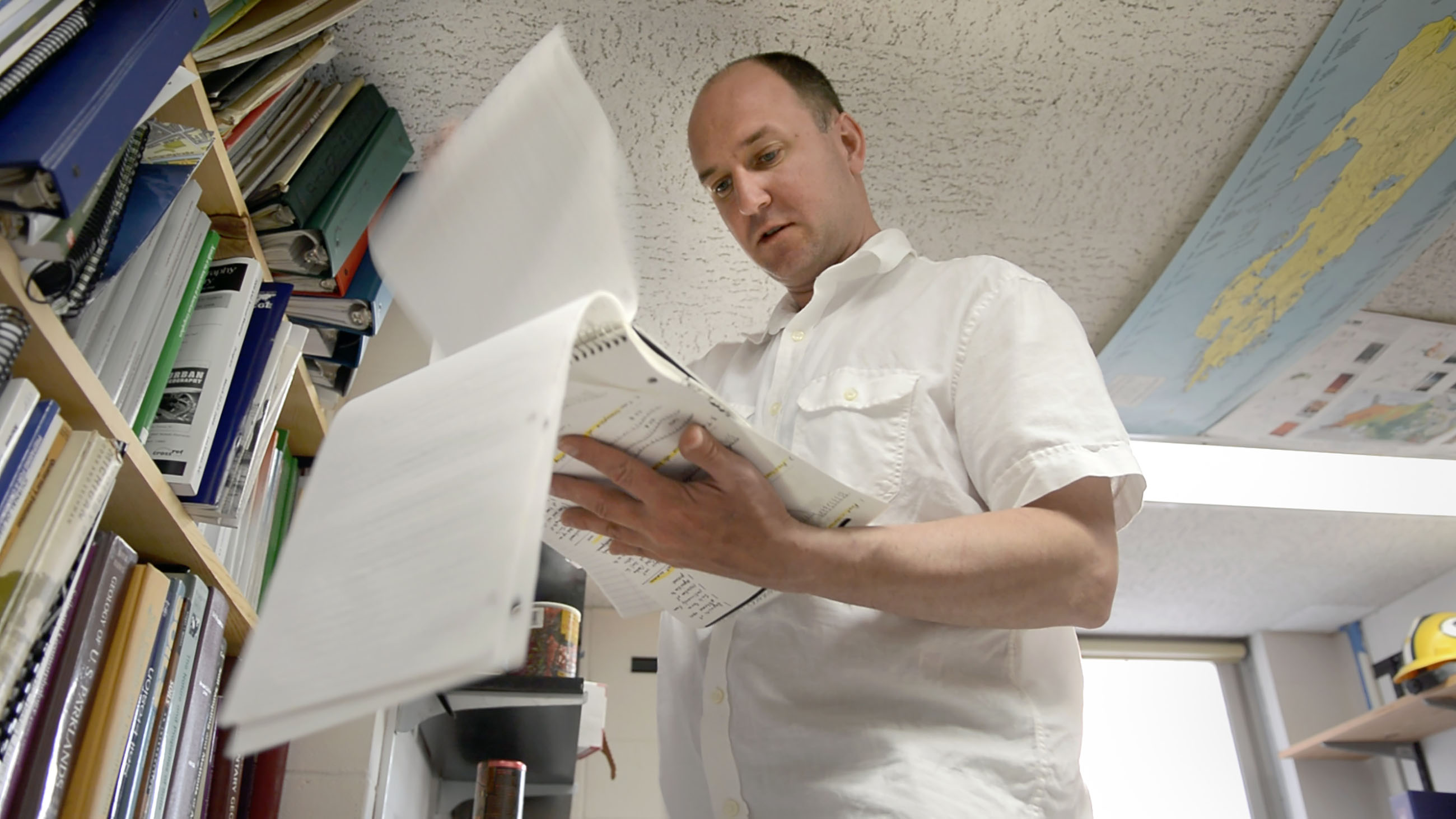
Khe Sanh is different. “When you look at Vietnam, it’s almost the opposite,” Hupy says. In 1968, more than 200 million pounds of munitions were expended by the U.S. here in pivotal fighting against the North Vietnamese Army. Dense, triple-canopy rainforest surrounded Khe Sanh before the war. Almost none remains.
The population surged after war. Ethnic communities were resettled in heavily bombed areas, which they kept devoid of trees, Hupy says. Economic reforms in the late 1980s sent even more people to the region. Craters were planted with coffee, and cattle grazed the lands between. Today, the geomorphology of Khe Sanh is a result of postwar economics, Hupy says, but it might not have happened that way without bombs clearing the way and leaving craters.
Dodging leeches and unexploded bombs, Hupy painstakingly gathered microtopographic data and soil samples from Khe Sanh’s craters. He found darker, wetter soils inside craters compared with those outside. Coffee planted in craters appeared to be more robust than coffee plants elsewhere. Moisture was higher and winds were lower inside craters than outside. Craters seemed to serve as little nurseries for plants, protected from grazing. (Cattle don’t go into craters.)
Across the border in Laos, researchers have also found evidence that the bombings altered local river flows. Two hundred miles southwest of Khe Sanh, scientists studied decades of hydro-meteorological data from a Mekong River Basin catchment and found sharp increases in runoff from the time of the bombings that remained higher than pre-war levels until the early 2000s. They suspect a cause-and-effect relationship.
“The principle is to compare the amount of water coming from rainfall (the input) to the water flowing down the rivers (the output),” says Alain Pierret, a biophysicist with the French National Institute for Research and Development. “The basic hypothesis is that part of the rainfall will infiltrate and part will run off the soil surface and increase the river flow.” If rainfall remains steady but flow increases, “then we can suspect that runoff is increasing and that it might be related to a change in land surface properties such as deforestation,” he says.
This is key: When a landscape is heavily bombed, the original forest canopy is often replaced by new vegetation with shallow roots; the new plants do not suck up as much moisture through roots and pores, and less moisture is converted to vapor. River runoff increases.
That is what researchers found in a southern Lao catchment: no significant change in rainfall but a peak in river discharge after the bombings climaxed. “Warfare-induced deforestation has more profound and durable hydrological effects than previously thought,” Pierret and his research partner, hydrologist Guillaume Lacombe, conclude.
By contrast, at a second catchment area in the north that was not bombed as much, a massive demographic shift occurred as villagers fled and Communists took over. Farms and cultivation fields were abandoned, and forests regrew. Consequently, runoff decreased after 1975. As in Khe Sanh, war sparked a sociological shift that in turn altered geomorphology.
This notion is central to Hupy’s ideas — an evolution in his original thinking. “I came out of WWI research thinking that landscapes were forever altered by the disturbance, and they alone set how that geographic landscape evolved,” he says. “This approach had the blinders of a geomorphologist seeking the pure, untouched landscapes.” But at Khe Sanh, “I saw firsthand how economic activities are deforesting the land, and the bombings are not the reason for the lack of forest.” Rather, bombings are a catalyst for landscape change. Economics, politics, and history, among other cultural factors, determine where that change leads.
Loy Phasavaeng would never have had this tilapia pond if it weren’t for those bombs. She would never have lived in Sekong. She certainly wouldn’t have sat in this chair telling me about the limbless bodies found in the fields, the malaria she and her children contracted, or the wisdom she’s gleaned as a small-scale farmer. (Chicken dung is great for growing spring onions, she insists.) And she wouldn’t be sitting here with an American sharing her hopes that one day there will be no more wars and no more bombs, anywhere. “Please don’t do war,” she says. This is her message to America.

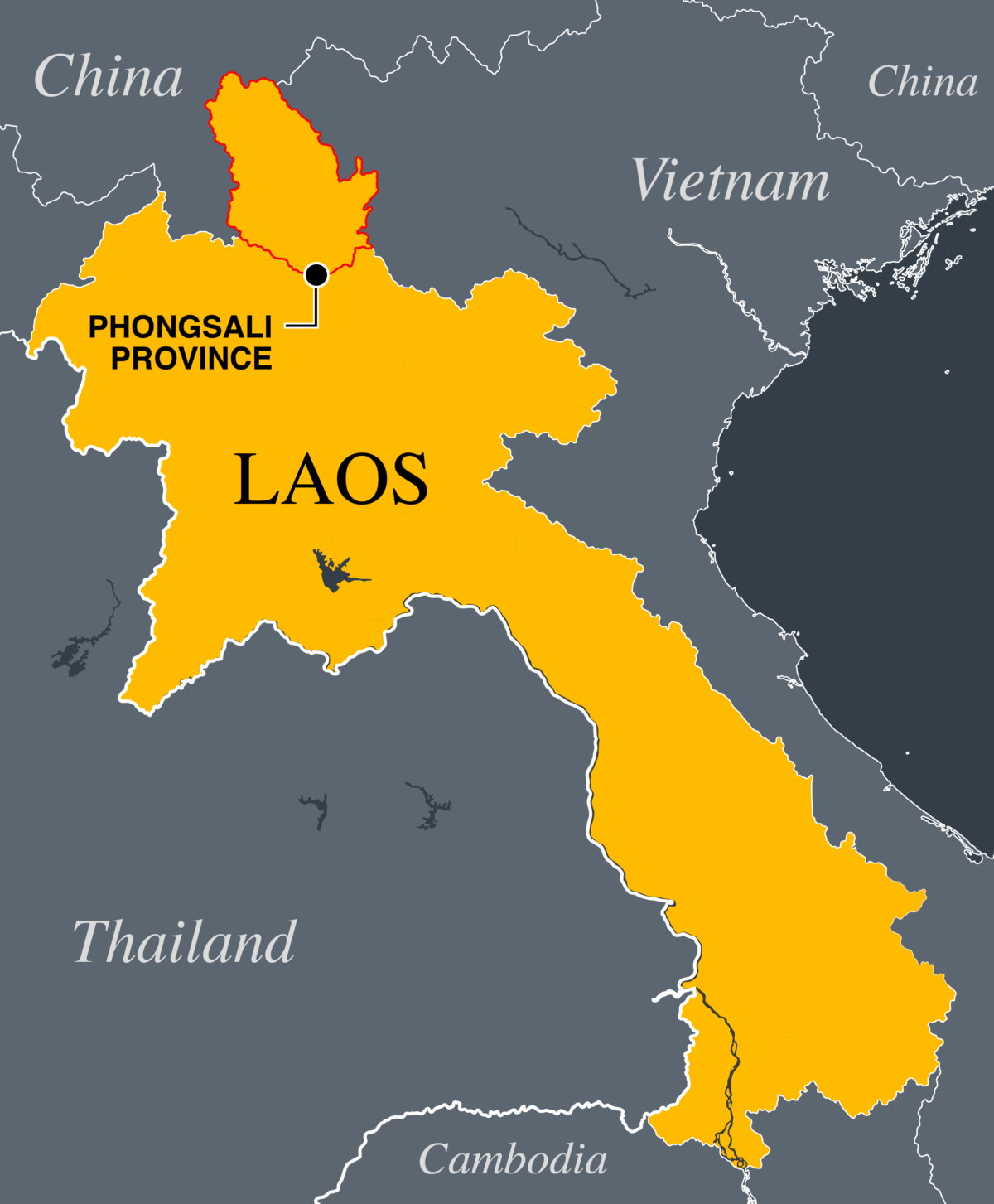
Right around the time we talk, a crater explodes 800 miles away in a little village called Sophoon in the far northern province of Phongsali. Sophoon is a village of craters. A few years back, a local kid named Dwee counted 58 — and he probably missed some.
It was an evening in late February of this year and a 70-year-old woman named Song was cooking dinner in her kitchen when BOOOM!, a blast from the backyard knocked her flat. “I saw smoke from the explosion come up to the sky,” she says. “It was a big bang, and I fell down.”
A man named Bing Paeng had piled dry leaves and yard scraps into an old crater in the backyard. He lit the fire and stood there for a few minutes, then went to the neighbor’s house to watch TV. That’s when the fire burst. Shrapnel scars on nearby trees and tiny metal balls found on the site indicate that a BLU-26 bomblet had been buried in the crater and exploded from the heat. Bing won’t burn rubbish there anymore, but he worries others might.
Often, when people find ordnance in their yards or fields, they toss it into a crater. It’s a depository for garbage of all types. Ask anyone in Sophoon, and they’ll tell you craters make practical dumps. You’ll find craters behind the local clinic filled with dirty needles and other medical waste. You’ll find a crater with ducks swimming through wastewater piped from a house uphill. And you’ll find craters put to production. Bing has another in his yard that stays moist through the year. He grows coffee and small coconut trees there until they are robust enough to transplant.
Talk to Paeng’s neighbor Noi, and she’ll show you the crater she filled with dirt to make a garden for sugarcane, lettuce, and lemongrass. Then talk to her sister, Awn, and she’ll tell you what a pain it is to fill a crater so a house can be built on top. It takes rocks dug from the nearby riverbed, then dirt found or bought from somewhere else. It takes a rental truck and sometimes labor that costs up to $1,000. And that takes saving up the profits from years of raising chickens, ducks and pigs. “We cannot fill up the hole in one go,” she says.
Craters send the residents of Sophoon on a different path of development. And you wonder: What are the ripple effects of all that? What happens to the river when its rocks are dug for filling holes? Or to the hillsides where dirt is extracted so a house can be built? Do wastewater craters encourage mosquitoes? Do they correlate with an increase in disease? (Westing and Pfeiffer wondered this back in 1972. They found craters that penetrated the water table, offering year-round breeding grounds and “greatly increasing the hazards of malaria and dengue fever.”)
Much remains to be studied. As Chu Thai Hoanh, emeritus scientist and former principal researcher with the International Water Management Institute, says, the long-term effects of bombings on the landscape should be considered before making decisions in war.
Warfare is much more widely accepted as a facet of the Anthropocene than it was during Hupy’s first forays onto battlefields. But bombturbation, as a geomorphologic field, remains mostly his own. Other scientists have written on increased dust storms in Iraq in the wake of bombings that destroyed the region’s topsoil, or Agent Orange in the food chain among villagers using bomb craters as fishponds in Vietnam. Others wonder if century-old pits in Greece are further examples of bombturbation, or whether battlefield remnants (explosives, human bones) might one day fossilize into the geologic record. But almost everything written on bombturbation loops back to Hupy’s research in France and Vietnam. Every scientist contacted for this story agrees: Bombturbation is worthy of further study.
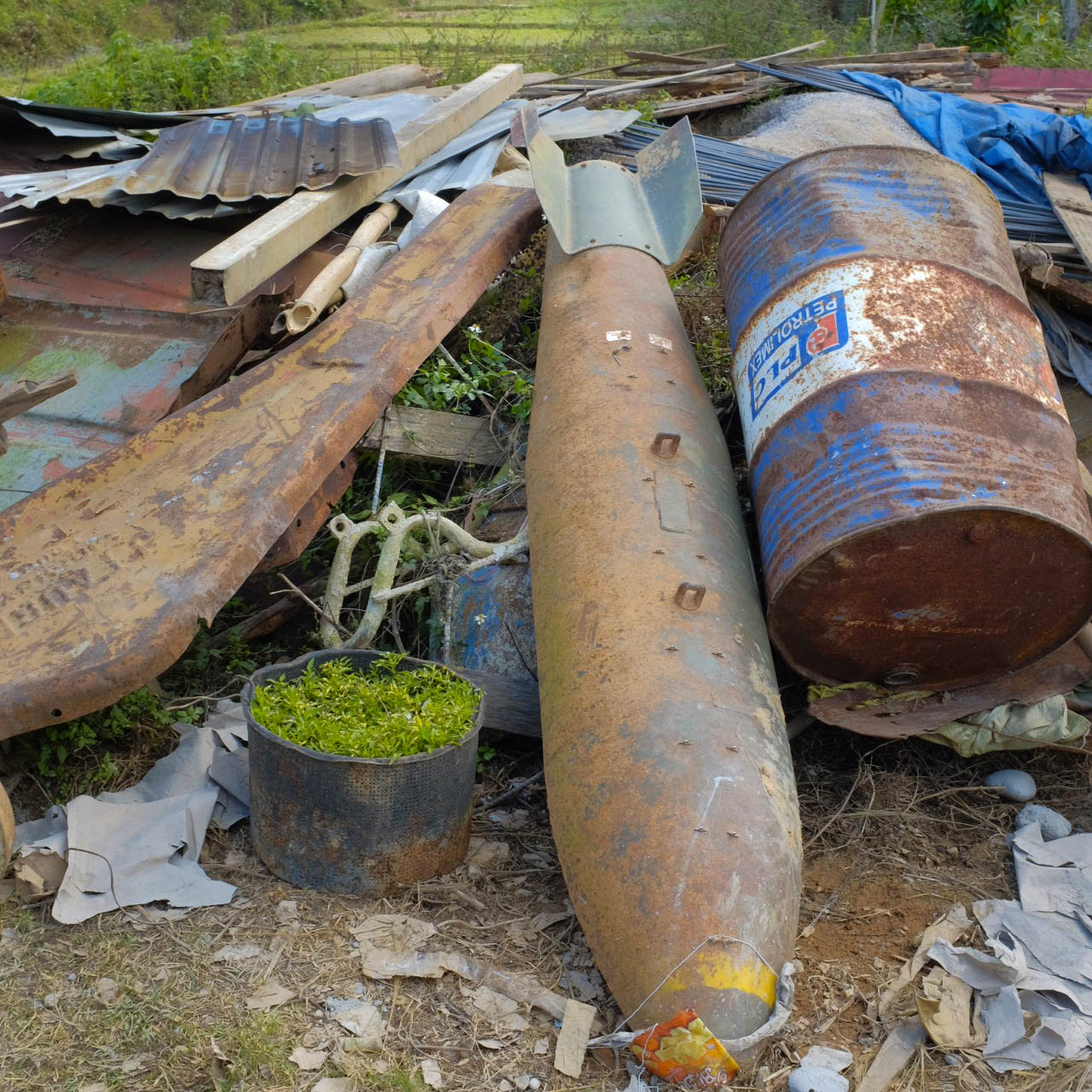
Human perceptions of the environment are shaped by what we see. But what we see isn’t always the whole story. It’s easy to look at Southeast Asia today and see changes far more pronounced than a collection of old craters. Roads, dams, mines, plantations, and massive logging operations all reshape the land. Laos has highways, homes, and cell phone towers in previously uninhabited areas. Vietnam has 94 million people today, up from 48 million in 1975. Many of the newcomers never saw the land before the bombs fell and the craters were formed. “Bombing was in the remote areas with low population,” Hoanh says, whereas development is everywhere. “Therefore people may have the impression that the effects of the latter are more significant.”
In fact, when we look at many of those roads, dams, mines, plantations and other forms of development today, we are viewing a postwar landscape shaped by its history. Is the land damaged? Is it moving towards recovery? “It’s difficult to say,” Hupy says, “but it’s definitely been pushed on a different path of development.”
Sitting on the edge of the fishpond, Loy tells me how the bombs that fell half a century ago have altered her environment ever since. And it’s not just about landscape, she says. Her whole life shifted with the bombings and their aftermath. “There were a lot of changes after the war.” Her village was uprooted, her farm was ruined, and her home was re-established in a city that didn’t exist previously. Her family used to grow rice; now they have a small garden and fish. When Loy looks at the pond behind her, she doesn’t see a crater. She sees a symbol of everything else.
There is a distinct relationship between the bombings and the way people live today, says Jim Harris, founder of a nonprofit called We Help War Victims. He spends months each year clearing unexploded bombs in remote areas of Laos, and he has accompanied us to this meeting with Loy. The stories of elders who survived the war help Harris understand how the bombings shape life and environment today. “There’s a symbiotic relationship between what we’ve done to the land and what the land has done to us,” he says. And it’s evident right here in Loy’s yard.
“We created the bomb crater,” Harris says, “but the bomb crater creates us.”
Karen J. Coates is a journalist and author who reports primarily on food, environment, health and human rights. She and her husband, photographer and videographer Jerry Redfern, co-produced the 2013 book “Eternal Harvest: The Legacy of American Bombs in Laos.”










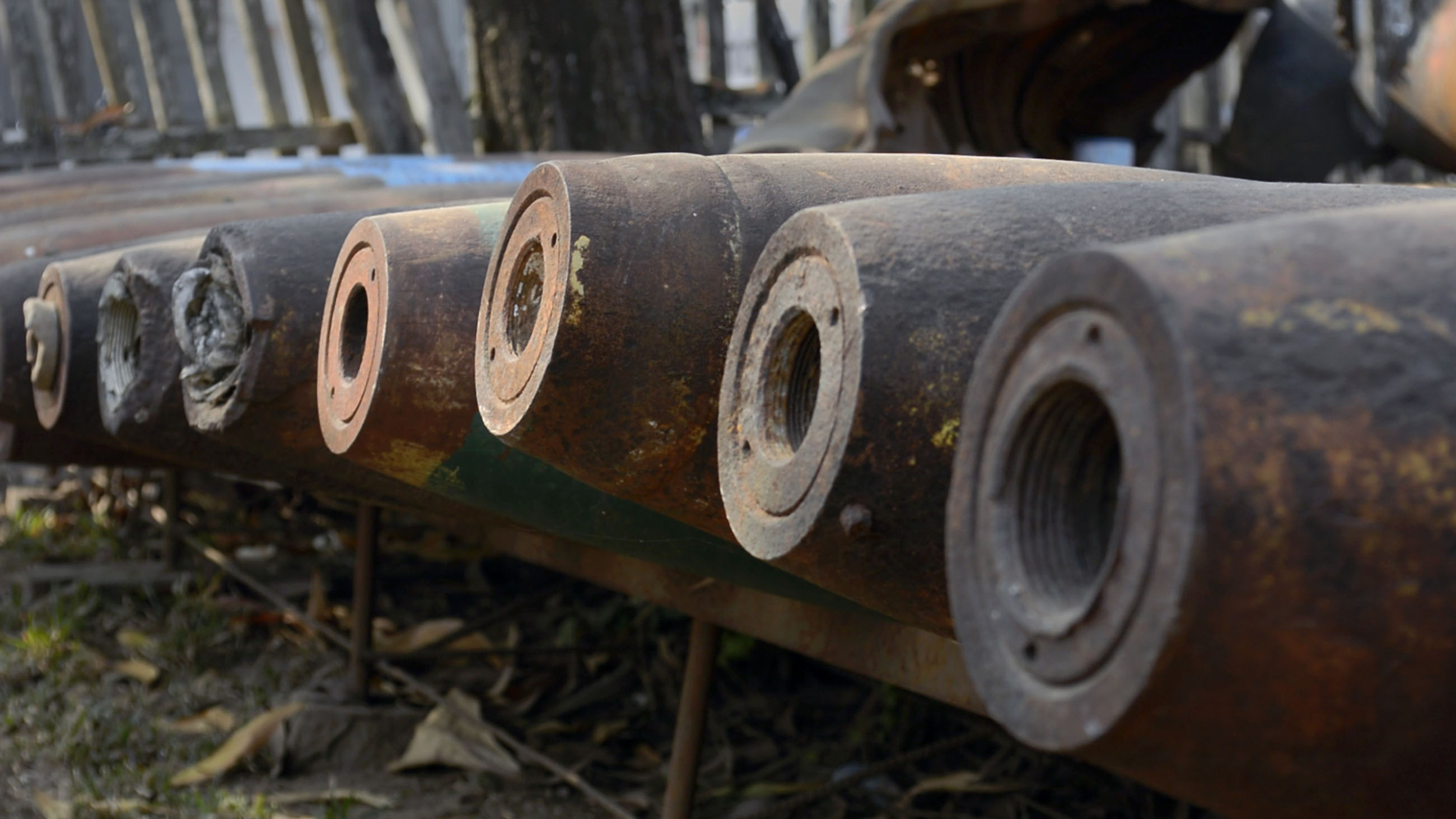
Comments are automatically closed one year after article publication. Archived comments are below.
I am late to reading this article, but happy to find it….”happy” to see scientists working on the long-lasting deleterious effects of war, and speaking up. Thanks.